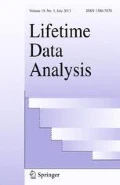Abstract
Multi-state models are frequently used when data come from subjects observed over time and where focus is on the occurrence of events that the subjects may experience. A convenient modeling assumption is that the multi-state stochastic process is Markovian, in which case a number of methods are available when doing inference for both transition intensities and transition probabilities. The Markov assumption, however, is quite strict and may not fit actual data in a satisfactory way. Therefore, inference methods for non-Markov models are needed. In this paper, we review methods for estimating transition probabilities in such models and suggest ways of doing regression analysis based on pseudo observations. In particular, we will compare methods using land-marking with methods using plug-in. The methods are illustrated using simulations and practical examples from medical research.










Similar content being viewed by others
References
Aalen OO, Johansen S (1978) An empirical transition matrix for nonhomogeneous Markov chains based on censored observations. Scand J Stat 5:141–150
Allignol A, Beyersmann J, Gerds TA, Latouche A (2014) A competing risks approach for nonparametric estimation of transition probabilities in a non-Markov illness–death model. Lifetime Data Anal 20:495–513
Andersen PK, Borgan Ø, Gill RD, Keiding N (1993) Statistical models based on counting processes. Springer, New York
Andersen PK, Keiding N (2002) Multi-state models for event history analysis. Stat Methods Med Res 11:91–115
Andersen PK, Klein JP, Rosthøj S (2003) Generalized linear models for correlated pseudo-observations, with applications to multi-state models. Biometrika 90:15–27
Andersen PK, Pohar Perme M (2008) Inference for outcome probabilities in multi-state models. Lifetime Data Anal 14:405–431
Andersen PK, Pohar Perme M (2010) Pseudo-observations in survival analysis. Stat Methods Med Res 19:71–99
Azarang L, Scheike T, Uña-Alvarez J (2017) Direct modeling of regression effects for transition probabilities in the progressive illness–death model. Stat Med 36:1964–1976
Cook RJ, Lawless JF (2018) Multistate models for the analysis of life history data. CRC/Chapman and Hall, Boca Raton
Cox DR (1972) Regression models and life-tables (with discussion). J R Stat Soc B 34:187–220
Datta S, Satten GA (2001) Validity of the Aalen–Johansen estimators of stage occupation probabilities and Nelson–Aalen estimators of integrated transition hazards for non-Markov models. Stat Probab Lett 55:403–411
Gill RD, Johansen S (1990) A survey of product-integration with a view towards application in survival analysis. Ann Stat 18:1501–1555
Malzahn N, Hoff R, Aalen OO, Mehlum IS, Putter H, Gran JM (2021) A hybrid landmark Aalen–Johansen estimator for transition probabilities in partially non-Markov multi-state models. Lifetime Data Anal 27:737–760
Meira-Machado L, Uña-Alvarez J, Cadarso-Saurez C (2006) Nonparametric estimation of transition probabilities in a non-Markov illness–death model. Lifetime Data Anal 13:325–344
Meira-Machado L, Sestelo M (2017) Estimation in the progressive illness–death model: a nonexhaustive review. Biom. J. 61:245–263
Mitton L, Sutherland H, Week M (eds) (2000) Microsimulation modelling for policy analysis. Challenges and innovations. Cambridge University Press, Cambridge
Overgaard M, Parner ET, Pedersen J (2017) Asymptotic theory of generalized estimating equations based on jack-knife pseudo-observations. Ann Stat 45:1988–2015
Pepe MS (1991) Inference for events with dependent risks in multiple endpoint studies. J Am Stat Assoc 86:770–778
PROVA Study Group (1991) Prophylaxis of first time hemorrage from esophageal varices by sclerotherapy, propranolol or both in cirrhotic patients: a randomized multicenter trial. Hepatology 14:1016–1024
Putter H, Spitoni C (2018) Non-parametric estimation of transition probabilities in non-Markov multi-state models: the landmark Aalen–Johansen estimator. Stat Methods Med Res 27:2081–2092
Rodriguez-Girondo M, Uña-Alvarez J (2012) A nonparametric test for Markovianity in the illness–death model. Stat Med 31:4416–4427
Scheike TH, Zhang M-J (2007) Direct modelling of regression effects for transition probabilities in multistate models. Scand J Stat 34:17–32
Shu Y, Klein JP, Zhang M-J (2007) Asymptotic theory for the Cox semi-Markov illness–death model. Lifetime Data Anal 13:91–117
Titman AC (2015) Transition probability estimates for non-Markov multi-state models. Biometrics 71:1034–1041
Titman AC, Putter H (2022) General tests of the Markov property in multi-state models. Biostatistics 23:380–396
Author information
Authors and Affiliations
Corresponding author
Additional information
Publisher's Note
Springer Nature remains neutral with regard to jurisdictional claims in published maps and institutional affiliations.
Supplementary Information
Below is the link to the electronic supplementary material.
Rights and permissions
About this article
Cite this article
Andersen, P.K., Wandall, E.N.S. & Pohar Perme, M. Inference for transition probabilities in non-Markov multi-state models. Lifetime Data Anal 28, 585–604 (2022). https://doi.org/10.1007/s10985-022-09560-w
Received:
Accepted:
Published:
Issue Date:
DOI: https://doi.org/10.1007/s10985-022-09560-w




